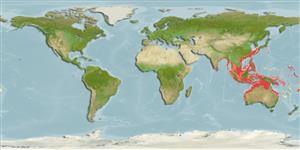Issue
Regarded a synonym of B. mcclellandi by some authors.
Environment: milieu / climate zone / depth range / distribution range
Ökologie
seewasser; brackwasser. Deep-water
Western Pacific: southern Taiwan to northwestern Australia (Ref. 7300); with confirmed distribution in Taiwan and probably extending to East China Sea and South China Sea (H.Ho, pers.comm. 2/2017).
Size / Gewicht / Alter
Maturity: Lm ? range ? - ? cm
Max length : 11.5 cm TL Männchen/unbestimmt; (Ref. 31443); common length : 6.7 cm SL Männchen/unbestimmt; (Ref. 5978)
Wirbelzahl: 13 - 43. Deciduous cycloid scales; small head naked. Small mouth slightly oblique; maxillary extending to posterior border of the pupil. Nuchal appendage in SL, about twice as head.
On the continental shelf.
Life cycle and mating behavior
Maturities | Fortpflanzung | Spawnings | Egg(s) | Fecundities | Larven
Paxton, J.R., D.F. Hoese, G.R. Allen and J.E. Hanley, 1989. Pisces. Petromyzontidae to Carangidae. Zoological Catalogue of Australia, Vol. 7. Australian Government Publishing Service, Canberra, 665 p. (Ref. 7300)
IUCN Rote Liste Status (Ref. 130435)
Bedrohung für Menschen
Harmless
Nutzung durch Menschen
Tools
Zusatzinformationen
Download XML
Internet Quellen
Estimates based on models
Preferred temperature (Ref.
123201): 21.7 - 28.3, mean 27.1 °C (based on 907 cells).
Phylogenetic diversity index (Ref.
82804): PD
50 = 0.5001 [Uniqueness, from 0.5 = low to 2.0 = high].
Bayesian length-weight: a=0.00407 (0.00189 - 0.00877), b=3.28 (3.09 - 3.47), in cm total length, based on LWR estimates for this species & (Sub)family-body (Ref.
93245).
Trophic level (Ref.
69278): 3.2 ±0.3 se; based on size and trophs of closest relatives
Fishing Vulnerability (Ref.
59153): Low vulnerability (10 of 100).
